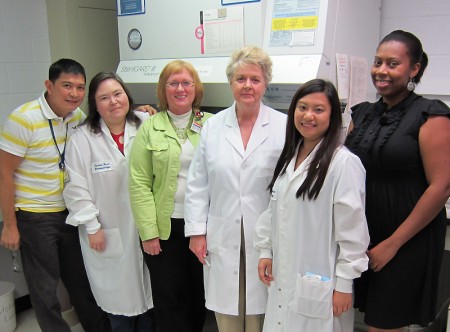
Cytokine Staff: Arden Bongco, Teresa Russ, Ame’ Maters, Dr. Barbara Detrick, Krystelle Banno and Maisha Cron
Nearly 10 years ago, under the directorship of Dr. Barbara Detrick, the Johns Hopkins University Cytokine Laboratory was established with the goal of fostering and improving basic, translational, and clinical research in cytokine biology. In 2003 this unique laboratory within the Department of Pathology became the first CLIA-approved cytokine laboratory in the nation. Since the laboratory’s inception we have offered cytokine analysis for research studies and clinical trials and have had an opportunity to collaborate with investigators both within and outside the JHU.
What are cytokines and why are they so important? The name cytokine comes from the Greek words cyto, meaning cell, and kinos, meaning movement. They are any number of small proteins secreted by various cell types. These molecules carry signals locally and systemically to a variety of cells. Cytokines are considered the bosses of the immune system. They are responsible for up-regulating (initiating), as well as down-regulating (turning off) the immune response. In addition to the immune response, cytokines act as multifunctional proteins that play an important role in hematopoesis, infectious diseases, homeostasis, tissue repair, cellular development, growth and tumorgenesis.
The flip side of cytokines is in their use as therapeutics. In many diseases, there is an up-regulation of the immune system. Sometimes that up-regulation can cause damage to the host. For instance, in Rheumatoid Arthritis (RA), a systemic autoimmune inflammatory disease, there is excess inflammation in the synovial joints which often leads to destruction of the articular cartilage and stiffness of the joints. Rheumatoid Arthritis can also produce inflammation in the lungs, pericardium, pleura and sclera, as well as nodular lesions in the subcutaneous tissue under the skin. The cytokine tumor necrosis factor (TNF) plays a critical role in producing the excess inflammation. Today, drugs have been designed to block TNF-alpha and other inflammatory cytokines by limiting inflammation and decreasing clinical symptoms. For example, one of the first FDA-approved anti-cytokine drugs was Etanercept (or Enbrel) which is used to treat RA by interfering with the production of TNF-alpha.
Because of their major involvement in numerous biologic processes and their therapeutic potential, there is a need to better identify and measure cytokines. We currently measure and quantitate cytokines by EIA, the gold standard for detecting cytokines. Moreover, we are in the process of evaluating a multiplex assay which allows us to screen specimens for multiple cytokines at the same time. One such approach is the Luminex technology. It combines flow cytometry, microshperes, lasers, digital signal processing, and traditional chemistry all rolled up into one assay. Furthermore, it is anticipated that we will expand to incorporate molecular testing as well. This additional dimension will position us to pursue cytokines at all levels of investigation.
Ame’ Maters
Manager, Microbiology and Immunology Laboratories